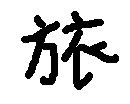(458) Teaching is learning [英作文]
Teaching is learning.
I learned again several new things about kanji (Chinese character). I learned it’s important and joyful to think of reasons why we follow some rules, such as stroke order of kanji.
I have helped a Kenyan elementary student do his homework for about two years.
One day, when I helped him with kanji homework I don’t know why, but I wrote 旅 wrongly. My student complained about my wrong kanji, because he had to correct his kanji as extra homework. He asked me do the same thing, so I practiced to write 旅
wrongly. My student complained about my wrong kanji, because he had to correct his kanji as extra homework. He asked me do the same thing, so I practiced to write 旅  on whole one page of my notebook.
on whole one page of my notebook.
I also noticed several wrong writing in my kanji, in stroke order and how to end each stroke while helping him with home work. He always neglects kanji stroke order. I tried to correct his way but he didn’t follow my instruction. First I thought kanji is foreign language for him, so he didn’t want to keep its rule of kanji stroke order. But this was wrong he writes zero and O differently from me. He started at the bottom point of O and makes a circle clockwise. He seemed to choose his best way to write alphabet and kanji by himself. He believes his way is best. His best way is write things most quickly and lest energy consuming. His main concern is that finishing his home work as
soon as possible and playing with his friends.
So I think of the merits of learning correct stroke-order of kanji.
・ You can write kanji characters physically
easily in the correct stroke-order for right-handed people.
・ You can write beautiful kanji characters.
A book named “Reading and writing CHINESE” also says that ‘Following the stroke-order diagrams presented in this book in order to acquire the correct habits early, and remember to keep you characters uniform in size.’ This is another merit of correct stroke-order. From this book let me show you the rules to explain the methods of stroke-order in general. These are the same as the rules kanji stroke-order in Japan.
1. Top to bottom: 言
2. Left to right: 他
3. Upper left corner to lower right corner:矢
4. Outside to inside: 国
5. When two or more strokes cross, horizontal strokes before perpendicular strokes: 十
6. Slanting stroke to the left before slanting stroke to the right: 人
7. Center stroke before symmetrical wings: 小
Japanese kanji dictionary for elementary students explain how we can right 十 with the correct
stroke-order. Beautiful 十 keeps its horizontal stroke balance in length. We can cross the horizontal stroke at the proper point with the perpendicular stroke. I like this explanation very much.
Although Chinese people and also Japanese people occasionally disagree among themselves about minor details, the traditional stroke-order has been developed and perfected through centuries of
experience. Learning the method is very meaningful and practical. Handwriting message of beautiful kanji surely make better communication with others.
*




コメント 0